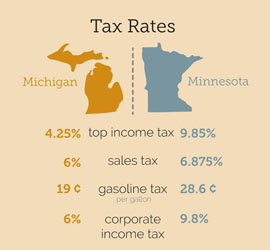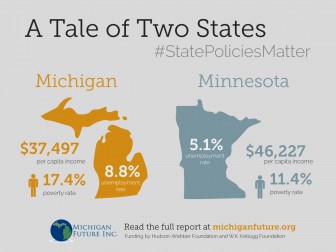Art Rolnick, the former director of research at the Minneapolis Federal Reserve Bank and an expert on economic development, says the secret to Minnesota’s decades of prosperity is found in its commitment to developing human capital.
“The key to the success of Minnesota’s economy over the past 50 years is the quality of its work force,” said Rolnick, co-director of the Human Capital Research Collaborative at the University of Minnesota’s Humphrey School of Public Affairs.
Minnesota has long been a leader in support for education, from preschool through higher education. The results of that commitment are impressive.
Last year’s graduating seniors in Minnesota posted an average composite score of 23.0 on the ACT test, the highest in the nation among the 28 states in which more than half the college-bound students took the test in 2013.
Minnesota has led the nation in average composite ACT scores for eight consecutive years. Thirty-nine percent of Minnesota high school students were deemed college-ready in all four subjects in the ACT last year, among the best in the country.
In Michigan, 21 percent of 2013 high school graduates were considered college ready. All of the state’s graduates were required to take the ACT, while about 74 percent of Minnesota’s graduates took the test.
The state’s investment in higher education—and its ability to retain and attract college graduates—has resulted in the state having one of the most highly educated work forces in the country, a clear advantage in growing a knowledge-based economy.
In 2012, 33.2 percent of Minnesotans had a bachelor’s degree or above, the 10th highest in the nation. Michigan ranked 36th with 26 percent of its residents having a bachelor’s degree or above.
Minnesota is a pioneer in recognizing the value of early childhood education for its youngest residents. A 2006 business-led pilot program in St. Paul led to the creation in 2011 of an organization called Parent Aware for School Readiness, which promotes a preschool rating system overseen by the Minnesota Department of Education.
Scholarships are awarded for students to attend only four-star-rated programs run by the private sector and public schools systems.
In the 2013 fiscal year Minnesota spent $153 million from state resources on preschool and childcare assistance and added $30 million more in the 2014 fiscal year.
Michigan also has committed more money to early childhood education. It boosted state funding by $65 million for the current fiscal year, more than any other state.
Minnesota spent $28 per capita on early childhood programming in the 2013 fiscal year, while Michigan spent $27 per capita.
Minnesota also outspent Michigan in K-12 funding by $620 per capita from state and local resources in 2013. Minnesota spent $2,067 per capita while Michigan spent $1,447 per capita on K-12 education.
Michigan’s spending of $14.6 billion in 2013 included $3.4 billion from local funding while Minnesota’s $11.1 billion included $2.3 billion from local property taxes.
Minnesota, a state with about 55 percent of the population of Michigan, spent about 75 percent as much as Michigan did on universities and community colleges in the 2013 fiscal year.
Michigan spent about $1.7 billion on higher education and community colleges, while Minnesota spent about $1.3 billion, mostly for the University of Minnesota and the 31 community colleges and state universities in the Minnesota State Colleges and Universities system.
That works out to $243 per capita in Minnesota compared to $172 per capita in higher education spending in Michigan.
Minnesota budgeted an additional $127.1 million for higher education in the 2014 and 2015 years in exchange for a tuition freeze in those years by its colleges and universities.
After years of cutting, Michigan also is boosting funding for higher education. The state’s 15 universities will share nearly $80 million in additional funding in the 2015 fiscal year. But they are required to limit tuition increases to 3.2 percent and meet certain performance goals to receive full funding.
“The increase will help universities make access to higher education available to more students, and give them the resources to continue serving as an important engine of entrepreneurship and research that is vital to growing an economy in the 21st century,” said Michael Boulus, executive director of the Presidents Council, State Universities of Michigan.
That’s something the Minnesota has long understood.

Read the latest report from Michigan Future here.







